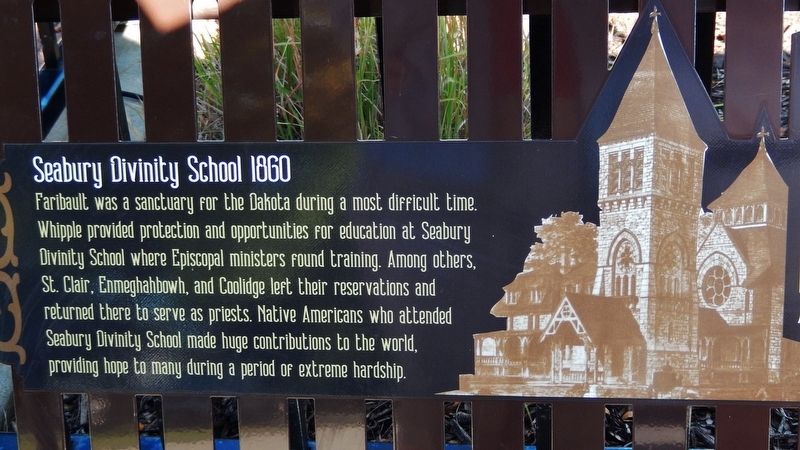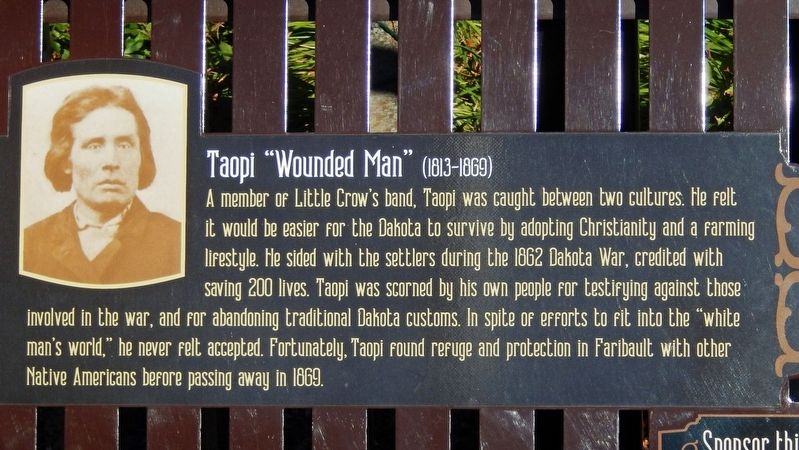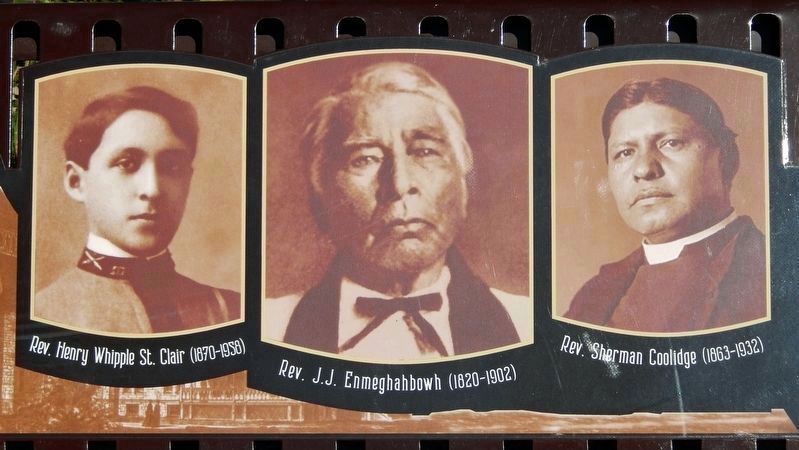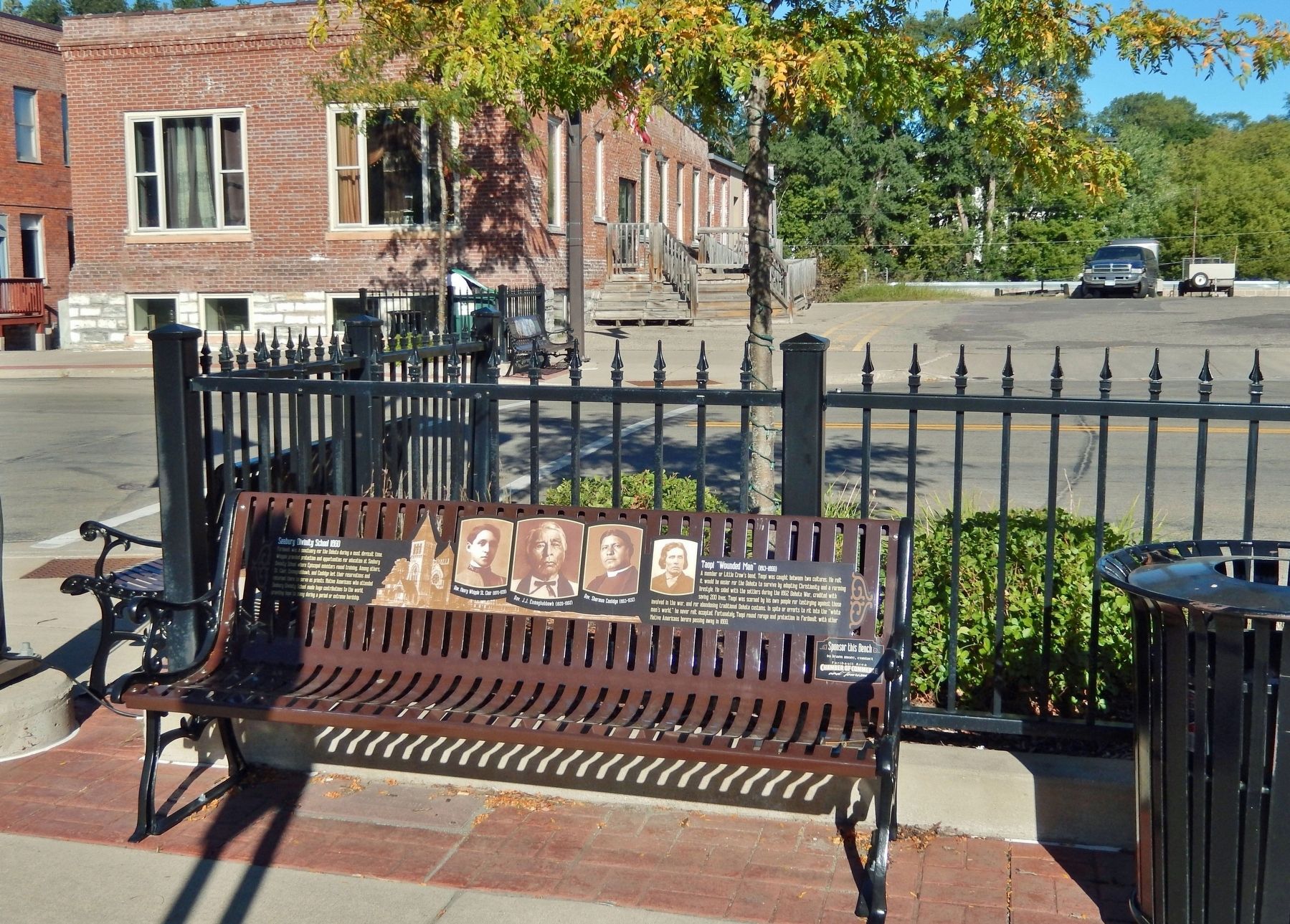Faribault in Rice County, Minnesota — The American Midwest (Upper Plains)
Seabury Divinity School & Taopi "Wounded Man"
Seabury Divinity School 1860
Faribault was a sanctuary for the Dakota during a most difficult time. Whipple provided protection and opportunities for education at Seabury Divinity School where Episcopal ministers found training. Among others, St. Clair, Enmeghahbowh, and Coolidge left their reservations and returned there to serve as priests. Native Americans who attended Seabury Divinity School made huge contributions to the world, providing hope to many during a period of extreme hardship.
Taopi "Wounded Man" (1813-1869)
A member of Little Crow's band, Taopi was caught between two cultures. He felt it would be easier for the Dakota to survive by adopting Christianity and a farming lifestyle. He sided with the settlers during the 1862 Dakota War, credited with saving 200 lives. Taopi was scorned by his own people for testifying against those involved in the war, and for abandoning traditional Dakota customs. In spite of efforts to fit into the "white man's world," he never felt accepted. Fortunately, Taopi found refuge and protection in Faribault with other Native Americans before passing away in 1869.
Topics. This historical marker is listed in these topic lists: Churches & Religion • Education • Native Americans • Wars, US Indian. A significant historical year for this entry is 1860.
Location. 44° 17.814′ N, 93° 16.114′ W. Marker is in Faribault, Minnesota, in Rice County. Marker is at the intersection of 6th Street Northwest and Central Avenue North, on the right when traveling east on 6th Street Northwest. Marker is mounted on a bench at the southwest corner of the intersection. Touch for map. Marker is at or near this postal address: 520 Central Avenue North, Faribault MN 55021, United States of America. Touch for directions.
Other nearby markers. At least 8 other markers are within walking distance of this marker. Faribault Riverfront 1880 (here, next to this marker); KDHL Radio (a few steps from this marker); Flour Milling & Woolen Milling (about 300 feet away, measured in a direct line); Minnesota State Academy for the Deaf (about 300 feet away); Downtown Faribault 1888 (about 400 feet away); The Faribault Fur Trade (about 400 feet away); OCHS Building (about 500 feet away); The Cathedral of Our Merciful Saviour (about 500 feet away). Touch for a list and map of all markers in Faribault.
Also see . . .
1. Seabury-Western Theological Seminary.
Seabury-Western Theological Seminary (SWTS) was a seminary of the Episcopal Church, located in Evanston, Illinois. Seabury-Western was formed in 1933 by a merger of Western Theological Seminary of Evanston (founded in 1883 in Chicago), and Seabury Divinity School of Faribault, Minnesota (founded in 1858). In 2013, it federated with Bexley Hall seminary to form the Bexley Hall Seabury Western Theological Seminary Federation, the federation then moved to the second floor of Chicago Theological Seminary in July 2016.(Submitted on December 11, 2022, by Cosmos Mariner of Cape Canaveral, Florida.)
2. How Chief Taopi, Bishop Whipple and Alexander Faribault helped Dakota find refuge.
The U.S.-Dakota War of 1862 divided those within the Dakota, and several Dakota, including Chief Taopi, formed the Dakota Peace Party as an attempt to secure the release of prisoners captured by the Dakota and to end the war.(Submitted on December 11, 2022, by Cosmos Mariner of Cape Canaveral, Florida.)Bishop Henry Whipple was the first Episcopal bishop of Minnesota when he arrived in 1859. He became an advocate of Native Americans while in Minnesota where they called him “Straight Tongue” for his honest approach with them.
Since Alexander Faribault’s arrival in the region that later took his name, it had been known as an area where Native Americans received support. Faribault’s grandmother was a Dakota, and he married a Dakota woman. Faribault and his family members served as government translators to help negotiate treaties. Faribault remained an advocate for American Indians throughout his life and was often referred to as a kinsman to the Dakota.
After the U.S.-Dakota War of 1862 ended and Whipple
helped strike a deal to allow Chief Taopi and his family to remain in the state, it was Faribault’s land that Taopi and his family lived on.
Credits. This page was last revised on December 11, 2022. It was originally submitted on December 9, 2022, by Cosmos Mariner of Cape Canaveral, Florida. This page has been viewed 179 times since then and 37 times this year. Photos: 1, 2, 3, 4. submitted on December 11, 2022, by Cosmos Mariner of Cape Canaveral, Florida.



